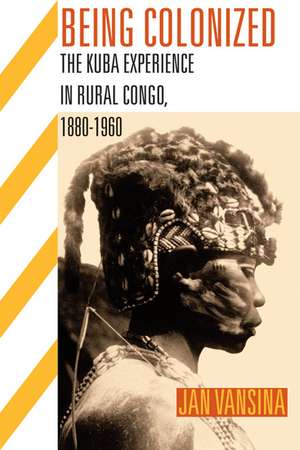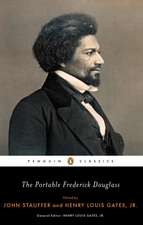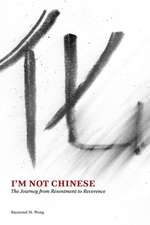Being Colonized: The Kuba Experience in Rural Congo, 1880–1960: Africa and the Diaspora: History, Politics, Culture
Autor Jan Vansinaen Limba Engleză Paperback – 17 mar 2010
What was it like to be colonized by foreigners? Highlighting a region in central Congo, in the center of sub-Saharan Africa, Being Colonized places Africans at the heart of the story. In a richly textured history that will appeal to general readers and students as well as to scholars, the distinguished historian Jan Vansina offers not just accounts of colonial administrators, missionaries, and traders, but the varied voices of a colonized people. Vansina uncovers the history revealed in local news, customs, gossip, and even dreams, as related by African villagers through archival documents, material culture, and oral interviews.
Vansina’s case study of the colonial experience is the realm of Kuba, a kingdom in Congo about the size of New Jersey—and two-thirds the size of its colonial master, Belgium. The experience of its inhabitants is the story of colonialism, from its earliest manifestations to its tumultuous end. What happened in Kuba happened to varying degrees throughout Africa and other colonized regions: racism, economic exploitation, indirect rule, Christian conversion, modernization, disease and healing, and transformations in gender relations. The Kuba, like others, took their own active part in history, responding to the changes and calamities that colonization set in motion. Vansina follows the region’s inhabitants from the late nineteenth century to the middle of the twentieth century, when a new elite emerged on the eve of Congo’s dramatic passage to independence.
Vansina’s case study of the colonial experience is the realm of Kuba, a kingdom in Congo about the size of New Jersey—and two-thirds the size of its colonial master, Belgium. The experience of its inhabitants is the story of colonialism, from its earliest manifestations to its tumultuous end. What happened in Kuba happened to varying degrees throughout Africa and other colonized regions: racism, economic exploitation, indirect rule, Christian conversion, modernization, disease and healing, and transformations in gender relations. The Kuba, like others, took their own active part in history, responding to the changes and calamities that colonization set in motion. Vansina follows the region’s inhabitants from the late nineteenth century to the middle of the twentieth century, when a new elite emerged on the eve of Congo’s dramatic passage to independence.
Din seria Africa and the Diaspora: History, Politics, Culture
-
 Preț: 164.51 lei
Preț: 164.51 lei -
 Preț: 165.36 lei
Preț: 165.36 lei -
 Preț: 507.02 lei
Preț: 507.02 lei -
 Preț: 216.96 lei
Preț: 216.96 lei -
 Preț: 172.75 lei
Preț: 172.75 lei -
 Preț: 241.30 lei
Preț: 241.30 lei -
 Preț: 235.42 lei
Preț: 235.42 lei -
 Preț: 319.98 lei
Preț: 319.98 lei -
 Preț: 427.26 lei
Preț: 427.26 lei -
 Preț: 240.43 lei
Preț: 240.43 lei - 15%
 Preț: 476.97 lei
Preț: 476.97 lei -
 Preț: 149.90 lei
Preț: 149.90 lei - 23%
 Preț: 476.07 lei
Preț: 476.07 lei -
 Preț: 505.08 lei
Preț: 505.08 lei -
 Preț: 539.68 lei
Preț: 539.68 lei -
 Preț: 205.29 lei
Preț: 205.29 lei -
 Preț: 265.45 lei
Preț: 265.45 lei - 23%
 Preț: 534.68 lei
Preț: 534.68 lei - 23%
 Preț: 475.06 lei
Preț: 475.06 lei - 23%
 Preț: 475.06 lei
Preț: 475.06 lei - 23%
 Preț: 471.92 lei
Preț: 471.92 lei - 23%
 Preț: 471.33 lei
Preț: 471.33 lei - 21%
 Preț: 343.29 lei
Preț: 343.29 lei - 19%
 Preț: 440.08 lei
Preț: 440.08 lei - 8%
 Preț: 529.24 lei
Preț: 529.24 lei
Preț: 258.96 lei
Nou
Puncte Express: 388
Preț estimativ în valută:
49.55€ • 52.99$ • 41.32£
49.55€ • 52.99$ • 41.32£
Carte tipărită la comandă
Livrare economică 17 aprilie-01 mai
Preluare comenzi: 021 569.72.76
Specificații
ISBN-13: 9780299236441
ISBN-10: 0299236447
Pagini: 348
Ilustrații: 26 b-w illus., 14 maps
Dimensiuni: 152 x 229 x 25 mm
Greutate: 0.48 kg
Ediția:1
Editura: University of Wisconsin Press
Colecția University of Wisconsin Press
Seria Africa and the Diaspora: History, Politics, Culture
ISBN-10: 0299236447
Pagini: 348
Ilustrații: 26 b-w illus., 14 maps
Dimensiuni: 152 x 229 x 25 mm
Greutate: 0.48 kg
Ediția:1
Editura: University of Wisconsin Press
Colecția University of Wisconsin Press
Seria Africa and the Diaspora: History, Politics, Culture
Recenzii
“A stunning achievement. Drawing on his years of research, Vansina reveals an ever-changing kaleidoscope of interactions between colonizers and colonized. This is colonial history firmly grounded in the thoughts and daily experiences of Africans. It will forever alter the way we think about the colonial period in Africa.”—Robert Harms, Yale University
“The book is also notable for its reliance on primary sources from the time itself––common with histories of American, European or Asian cultures, but exceptional in African history. Using the rigorous documentation of his own experiences, Vansina aimed to write something radically different than the texts usually used by undergraduates. The resulting approach speaks to both intellect and imagination.”––Susannah Brooks, Wisconsin Week
“This may be Vansina’s best book yet. . . . He has trodden the Kuba ground, talked to the people, and collected data for a half century, giving the book greater intimacy and authority than anything else he has written. . . .In African historiography we are all Vansina’s students, even when we argue with him. Being Colonized is written with the assurance of a master.”—Wyatt MacGaffey, Africa: The Journal of the International African Institute
Notă biografică
Jan Vansina, now emeritus, held the John D. and Catherine T. MacArthur Professorship and the Vilas Professorship in History and Anthropology at the University of Wisconsin–Madison. His many books include his memoir Living with Africa, as well as Oral Tradition as History, Antecedents to Rwanda, Kingdoms of the Savanna, The Children of Woot, and Paths in the Rainforests, all published by the University of Wisconsin Press. Considered one of the founders of the academic field of African studies, he was the second scholar chosen as “Distinguished Africanist” by the African Studies Association of the United States.
Cuprins
List of Illustrations
Acknowledgments
A Note on Spelling and Pronunciation
Introduction
1 Congo: Becoming a Colony
2 The Colonial Relationship
3 Incidental Conquest
4 Company Rule and Its Consequences
5 Were the Kuba Nearly Wiped Out?
6 Fifty Years of Belgian Rule: An Overview
7 A Kingdom Preserved
8 Village Life: 1911–1950s
9 In Pursuit of Harmony
10 Visions for a Different Future
11 Toward a New World
Conclusion: The Experience of Being Colonized
Index
Acknowledgments
A Note on Spelling and Pronunciation
Introduction
1 Congo: Becoming a Colony
2 The Colonial Relationship
3 Incidental Conquest
4 Company Rule and Its Consequences
5 Were the Kuba Nearly Wiped Out?
6 Fifty Years of Belgian Rule: An Overview
7 A Kingdom Preserved
8 Village Life: 1911–1950s
9 In Pursuit of Harmony
10 Visions for a Different Future
11 Toward a New World
Conclusion: The Experience of Being Colonized
Index
Descriere
What was it like to be colonized by foreigners? Highlighting a region in central Congo, in the center of sub-Saharan Africa, Being Colonized places Africans at the heart of the story. In a richly textured history that will appeal to general readers and students as well as to scholars, the distinguished historian Jan Vansina offers not just accounts of colonial administrators, missionaries, and traders, but the varied voices of a colonized people. Vansina uncovers the history revealed in local news, customs, gossip, and even dreams, as related by African villagers through archival documents, material culture, and oral interviews.
Vansina’s case study of the colonial experience is the realm of Kuba, a kingdom in Congo about the size of New Jersey—and two-thirds the size of its colonial master, Belgium. The experience of its inhabitants is the story of colonialism, from its earliest manifestations to its tumultuous end. What happened in Kuba happened to varying degrees throughout Africa and other colonized regions: racism, economic exploitation, indirect rule, Christian conversion, modernization, disease and healing, and transformations in gender relations. The Kuba, like others, took their own active part in history, responding to the changes and calamities that colonization set in motion. Vansina follows the region’s inhabitants from the late nineteenth century to the middle of the twentieth century, when a new elite emerged on the eve of Congo’s dramatic passage to independence.
Vansina’s case study of the colonial experience is the realm of Kuba, a kingdom in Congo about the size of New Jersey—and two-thirds the size of its colonial master, Belgium. The experience of its inhabitants is the story of colonialism, from its earliest manifestations to its tumultuous end. What happened in Kuba happened to varying degrees throughout Africa and other colonized regions: racism, economic exploitation, indirect rule, Christian conversion, modernization, disease and healing, and transformations in gender relations. The Kuba, like others, took their own active part in history, responding to the changes and calamities that colonization set in motion. Vansina follows the region’s inhabitants from the late nineteenth century to the middle of the twentieth century, when a new elite emerged on the eve of Congo’s dramatic passage to independence.











